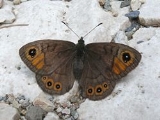
Lasiommata petropolitana
Encyclopedia
The Northern Wall Brown (Lasiommata petropolitana) is a butterfly
species belonging to the family
Nymphalidae
. It can be found in large parts of Europe
, from the Pyrenees
and Alps
up to Scandinavia
and Finland
, up to Russia
and Siberia
.
.jpg) The males are 19-21 mm. The butterflies fly in one or two generations from April to September.
The males are 19-21 mm. The butterflies fly in one or two generations from April to September.
The larvae feed on various grasses, mainly Dactylis glomerata
, Festuca rubra
and Festuca ovina .
Butterfly
A butterfly is a mainly day-flying insect of the order Lepidoptera, which includes the butterflies and moths. Like other holometabolous insects, the butterfly's life cycle consists of four parts: egg, larva, pupa and adult. Most species are diurnal. Butterflies have large, often brightly coloured...
species belonging to the family
Family (biology)
In biological classification, family is* a taxonomic rank. Other well-known ranks are life, domain, kingdom, phylum, class, order, genus, and species, with family fitting between order and genus. As for the other well-known ranks, there is the option of an immediately lower rank, indicated by the...
Nymphalidae
Nymphalidae
The Nymphalidae is a family of about 5,000 species of butterflies which are distributed throughout most of the world. These are usually medium sized to large butterflies. Most species have a reduced pair of forelegs and many hold their colourful wings flat when resting. They are also called...
. It can be found in large parts of Europe
Europe
Europe is, by convention, one of the world's seven continents. Comprising the westernmost peninsula of Eurasia, Europe is generally 'divided' from Asia to its east by the watershed divides of the Ural and Caucasus Mountains, the Ural River, the Caspian and Black Seas, and the waterways connecting...
, from the Pyrenees
Pyrenees
The Pyrenees is a range of mountains in southwest Europe that forms a natural border between France and Spain...
and Alps
Alps
The Alps is one of the great mountain range systems of Europe, stretching from Austria and Slovenia in the east through Italy, Switzerland, Liechtenstein and Germany to France in the west....
up to Scandinavia
Scandinavia
Scandinavia is a cultural, historical and ethno-linguistic region in northern Europe that includes the three kingdoms of Denmark, Norway and Sweden, characterized by their common ethno-cultural heritage and language. Modern Norway and Sweden proper are situated on the Scandinavian Peninsula,...
and Finland
Finland
Finland , officially the Republic of Finland, is a Nordic country situated in the Fennoscandian region of Northern Europe. It is bordered by Sweden in the west, Norway in the north and Russia in the east, while Estonia lies to its south across the Gulf of Finland.Around 5.4 million people reside...
, up to Russia
Russia
Russia or , officially known as both Russia and the Russian Federation , is a country in northern Eurasia. It is a federal semi-presidential republic, comprising 83 federal subjects...
and Siberia
Siberia
Siberia is an extensive region constituting almost all of Northern Asia. Comprising the central and eastern portion of the Russian Federation, it was part of the Soviet Union from its beginning, as its predecessor states, the Tsardom of Russia and the Russian Empire, conquered it during the 16th...
.
.jpg)
The larvae feed on various grasses, mainly Dactylis glomerata
Dactylis glomerata
Dactylis glomerata, Cock's-foot and orchard grass, is a common species of grass in the genus Dactylis, native throughout most of Europe, temperate Asia, and northern Africa.-Distribution:...
, Festuca rubra
Festuca rubra
Festuca rubra is a species of grass known by the common name red fescue. It is found worldwide and can tolerate many habitats and climates; it generally needs full sun to thrive...
and Festuca ovina .

